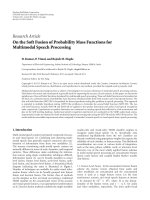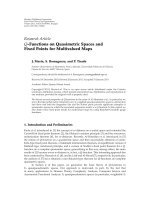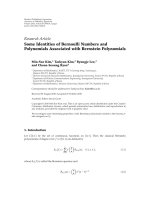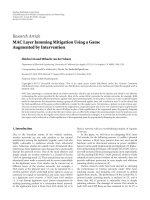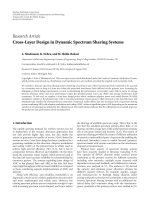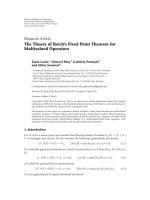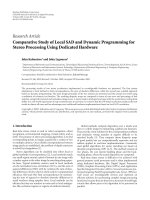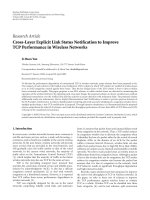Báo cáo hóa học: " Research Article Physical Layer Built-In Security Analysis and Enhancement Algorithms for CDMA Systems" pptx
Bạn đang xem bản rút gọn của tài liệu. Xem và tải ngay bản đầy đủ của tài liệu tại đây (613.12 KB, 7 trang )
Hindawi Publishing Corporation
EURASIP Journal on Wireless Communications and Networking
Volume 2007, Article ID 83589, 7 pages
doi:10.1155/2007/83589
Research Article
Physical Layer Built-In Security Analysis and Enhancement
Algorithms for CDMA Systems
Tongtong Li, Qi Ling, and Jian Ren
Department of Electrical and Computer Engineering, Michigan State University, East Lansing, MI 48824, USA
Received 18 July 2006; Revised 23 December 2006; Accepted 20 January 2007
Recommended by Wei Li
Historically developed for secure communication and military use, CDMA has been identified as a major modulation and
multiple-access technique for 3G systems and beyond. In addition to the wide bandwidth and low power-spectrum density which
make CDMA signals robust to narrowband jamming and easy to be concealed within the noise floor, the physical layer built-in
information privacy of CDMA system is provided by pseudorandom scrambling. In this paper, first, security weakness of the oper-
ational and proposed CDMA airlink interfaces is analyzed. Second, based on the advanced encryption standard (AES), we propose
to enhance the physical layer built-in security of CDMA systems through secure scrambling. Performance analysis demonstrates
that while providing significantly improved information privacy, CDMA systems with secure scrambling have comparable com-
putational complexity and overall system performance with that of conventionally scrambled systems. Moreover, it is shown that
by scrambling the training sequence and the message sequence separately with two independent scrambling sequences, both in-
formation privacy and system performance can be further improved. The proposed scheme can readily be applied to 3G systems
and beyond.
Copyright © 2007 Tongtong Li et al. This is an open access article distributed under the Creative Commons Attribution License,
which permits unrestricted use, distribution, and reproduction in any medium, provided the or iginal work is properly cited.
1. INTRODUCTION
As people are relying more and more on wireless commu-
nication networks for critical information transmission, se-
curity has become an urgent issue and a bottleneck for new
wireless communication services such as wireless mobile In-
ternet and e-commerce [1]. Due to user mobility and the fact
that there is no physical boundary in wireless environment,
wireless communication networks are facing much more sig-
nificant challenges compared to their data network counter-
parts.
Direct sequence spread-spectrum system, also known
as code-division multiple access (CDMA), was historically
developed for secure communication and military use. In
CDMA systems, each user is assigned a specific spreading se-
quence to modulate its message signal. The spreading process
increases the bandwidth of the message signal by a factor N,
known as spreading factor or the processing gain, and mean-
while reduces the power-spectrum density of the signal also
by a factor N. With large bandwidth and low power spectrum
density, CDMA signals are resistant to malicious narrowband
jamming and can easily be concealed within the noise floor,
preventing from being detected by an unauthorized person.
Moreover, the message signal cannot be recovered unless the
spreading sequence is known, this makes it difficult for unau-
thorized person to intercept the signal.
Due to high spectrum efficiency and simplicity in sys-
tem planning, CDMA is now finding widespread civilian and
commercial applications such as cellular phones, personal
communications, and position location. As it is well known,
CDMA is used in the US digital cellular standard IS-95 and
has been identified as the major modulation technique for
third generation (3G) wireless communications and be yond.
Relying on the long pseudorandom spreading sequence
generator, the operational CDMA system (IS-95) and the
proposed 3G UMTS system can provide a near-satisfactory
physical layer built-in securit y solution to voice centric wire-
less communications, which generally last only a very short
period of time. However, the security features provided by
these systems a re far from being adequate and being accept-
able when used for data communications. In literature, wire-
less security is generally considered from MAC layer and net-
work layer, see [2], for example, and few thoughts have been
given to the physical layer security enhancement. In this pa-
per, we show that by combining cryptographic techniques
and modulation techniques in the transmitter and receiver
2 EURASIP Journal on Wireless Communications and Networking
design, physical layer built-in security of wireless systems can
be exploited to ensure wireless network security from both
the physical layer and upper layers. In the following sections,
first, security weakness of the existing CDMA airlink inter-
faces is analyzed. Second, instead of using the conventional
scrambling method as in IS-95 or 3GPP UMTS, encrypted
long code based on advanced encryption standard (AES) is
proposed to be used in the scrambling process. It will be
seen that ensured by AES, the proposed scheme can improve
the physical layer built-in security of CDMA systems sig nifi-
cantly. Moreover, it is shown that by scrambling the training
sequence and the message sequence separately with two in-
dependent scrambling sequences, both information privacy
and system performance can be further improved. The pro-
posed scheme is easy to implement and can readily be applied
to 3G systems and beyond.
2. PHYSICAL LAYER SECURITY EVALUATION OF
IS-95 AND 3GPP UMTS CDMA SYSTEMS
In the operational and proposed direct-sequence CDMA
(DS-CDMA) systems, as shown in Figure 1,eachuser’ssig-
nal is first spread using a code sequence (know n as chan-
nelization code ) spanning over just one symbol or multiple
symbols. The spread sig nal is then fur ther scrambled using a
pseudorandom sequence, to randomize the interference and
meanwhile makes it difficult to intercept and detect the trans-
mitted signal.
Consider a DS-CDMA system with M users and K receive
antennas. Assuming the processing g a in is N, that is, there are
N chips per symbol. Let u
j
(k)(j = 1, , M) denote user j’s
kth symbol. Without loss of generality, let
c
j
=
c
j
(0), c
j
(1), , c
j
(N − 1)
(1)
denote user j’s channelization code or spreading code. The
spread chip-rate signal can be expressed as
r
j
(n) =
∞
k=−∞
u
j
(k)c
j
(n − kN). (2)
The successive scrambling process is achieved by
s(n)
= r
j
(n)d
j
(n), (3)
where d
j
(n) is the chip-rate scrambling sequence of user j.
Let
{g
(i)
j
(l ) }
L−1
l
=0
denote the (chip-rate) channel impulse
response from jth user to ith antenna, the received chip-rate
signal at the ith antenna (i
= 1, 2, , K) can be expressed as
y
i
(n) =
M
j=1
L
−1
l=0
g
(i)
j
(l ) s
j
(n − l)+w
i
(n), (4)
where w
i
(n) is the additive noise.
From (4), we can see that it is impossible to recover the
desired user’s signal without knowing both the user’s chan-
nelization code and scrambling code. This is known as the
built-in security feature of the CDMA systems.
Since the channelization codes are chosen to be Walsh
codes, which are easy to generate, the physical layer built-in
security of CDMA systems mainly relies on the long pseu-
dorandom scrambling sequence, also known as long code.
In the following, we will analyze the maximum complexity
to recover the long code of the IS-95 system and the 3GPP
UMTS system.
2.1. Scrambling code recovery of the IS-95 system
In IS-95, the long-code generator consists of a 42-bit number
called long-code mask and a 42-bit linear feedback shift reg-
ister (LFSR) specified by the following characteristic polyno-
mial:
x
42
+ x
35
+ x
33
+ x
31
+ x
27
+ x
26
+ x
25
+ x
22
+ x
21
+ x
19
+ x
18
+ x
17
+ x
16
+ x
10
+ x
7
+ x
6
+ x
5
+ x
3
+ x
2
+ x +1,
(5)
where the 42-bit long code mask is shared between the mo-
bile and let the base station.
As shown in Figure 2, each chip of the long code is gen-
erated by the modulo-2 inner product of a 42-bit mask and
the 42-bit state vector of the LFSR.
Let M
= [m
1
, m
2
, , m
42
] denote the 42-bit mask and
S(t)
= [s
1
(t), s
2
(t), , s
42
(t)] denote the state of the LFSR at
time instance t. The long-code sequence c(t)attimet can
thus be represented as
c(t)
= m
1
s
1
(t)+m
2
s
2
(t)+···+ m
42
s
42
(t), (6)
where the additions are modulo-2 additions.
As it is well known, for a sequence generated from an
n-stage linear feedback shift register, if an eavesdropper can
intercept a 2n-bit sequence segment, then the characteristic
polynomial and the entire sequence can be reconstructed ac-
cording to the Berlekamp-Massey algorithm [3]. This leaves
an impression that the maximum complexity to recover the
long-code sequence c(t)isO(2
84
). However, for IS-95, since
the characteristic polynomial is known to the public, an
eavesdropper only needs to obtain 42 bits of the long-code
sequence to determine the entire sequence. That is, the max-
imum complexity to recover the long-code sequence c(t)is
only O(2
42
).
In fac t, since s
1
(t), s
2
(t), , s
42
(t) are the outputs of the
same LFSR, they should all be the same except for a phase
difference, that is,
s
42
(t) = s
41
(t − 1) =··· =s
1
(t − 41). (7)
Let a
= [a
1
, a
2
, , a
42
] denote of the coefficient vector of the
characteristic polynomial in (5), then it follows from (7) that
s
i
(t) = a
1
s
i−1
(t)+a
2
s
i−2
(t)+···+ a
42
s
i−42
(t)
= a
1
s
i
(t − 1) + a
2
s
i
(t − 2) + ···+ a
42
s
i
(t − 42).
(8)
Tongtong Li et al. 3
User j
s signal at
symbol rate
u
j
(k)
Spreading or
channelization
r
j
(n)
Spread signal at
chip rate
Pseudorandom
scrambling
s
j
(n)
Scrambled signal
at chip rate
Channel
g
(i)
j
(n)
Noise
y
(i)
j
(n)
Figure 1: Block diagram of a long-code DS-CDMA system.
123 404142
s
1
s
2
s
3
s
40
s
41
s
42
Modulo-2 addition
LSB
42
Long code mask Long code sequence
MSB
Figure 2: IS-95 long-code generator.
Substituting (8) into (6), we have
c(t)
=
42
i=1
m
i
s
i
(t) =
42
i=1
m
i
42
j=1
a
j
s
i
(t − j)
=
42
j=1
a
j
42
i=1
m
i
s
i
(t − j)
=
42
j=1
a
j
c(t − j).
(9)
Define
A
=
⎡
⎢
⎢
⎢
⎢
⎢
⎢
⎣
a
1
10··· 0
a
2
01··· 0
.
.
.
.
.
.
.
.
.
.
.
.
.
.
.
a
41
00··· 1
a
42
00··· 0
⎤
⎥
⎥
⎥
⎥
⎥
⎥
⎦
, (10)
then it follows that
c(t), c (t − 1), , c(t − 41)
=
c(t − 1), c(t − 2), , c(t − 42)
∗
A.
(11)
Let C(t) = [c(t), c(t−1), , c(t−41)], then for any n ≥ t,
from (11)wehave
C(n)
= C(t) ∗ A
n−t
. (12)
Therefore, as long as C(t) for a time instance t is known,
then the entire sequence can be recovered. In other words, as
long as an eavesdropper can intercept/recover up to 42 con-
tinuous long-code sequence bits, then the whole long-code
sequence can be regenerated. Therefore, the long code se-
quence of IS-95 is vulnerable under ciphertext-only attacks
as the maximum complexity to recover it is only O(2
42
).
2.2. Scrambling code recovery of the
3GPP UMTS system
In the 3GPP UMTS standard, Gold codes generated from two
generator polynomials of degree 18 are used as scrambling
code, as shown in Figure 3.
Denote the states for the two LFSRs at time instance t
as r(t)
= [r
17
(t), r
16
(t), , r
1
(t), r
0
(t)] and s(t) = [s
17
(t),
s
16
(t), , s
1
(t), s
0
(t)], where
r
17
(t) = r
7
(t − 1) + r
0
(t − 1),
s
17
(t) = s
10
(t − 1) + s
7
(t − 1) + s
5
(t − 1) + s
0
(t − 1).
(13)
Then at time instance t,sequenceI can be written as
I(t)
= r
0
(t − 1) + s
0
(t − 1), (14)
while sequence Q can be expressed as
Q(t)
=
17
i=0
a
i
r
i
(t − 1) +
17
i=0
b
i
s
i
(t − 1), (15)
where a
i
and b
i
areeither0or1asshowninFigure 3.
Note that r
0
(t) = r
1
(t − 1) = ··· = r
17
(t − 17) and
s
0
(t) = s
1
(t − 1) =··· =s
17
(t − 17), we have
Q(t)
=
17
i=0
a
i
r
0
(t + i − 1) +
17
i=0
b
i
s
0
(t + i − 1). (16)
From (14)and(16), it follows that the maximum complexity
to recover the scrambling code of the 3GPP UMTS system
based on ciphertext-only attack is O(2
36
).
This implies that the physical layer built-in security of the
3GPP UMTS is actually weaker than that of the IS-95 system,
therefore, in the subsequent sections, we will focus on the
IS-95 system and the results can be directly applied to 3GPP
systems.
Once the long-code sequence is recovered, the desired
user’s signal can be recovered through signal separation and
extraction techniques. If the training sequence is known,
simple receivers, for example, the Rake receiver, can be used
to extract the desired user’s signal. Even if the training se-
quence is unknown, the desired user’s signal can still be re-
covered through blind multiuser detection and signal sepa-
ration algorithms, see [4–6], for example.
3. AES-BASED SECURITY ENHANCEMENT OF
THE SCRAMBLING PROCESS
As can be seen from the previous sections, the physical layer
security of CDMA systems relies on the scrambling process,
4 EURASIP Journal on Wireless Communications and Networking
r
17
r
16
r
15
r
14
r
13
r
12
r
11
r
10
r
9
r
8
r
7
r
6
r
5
r
4
r
3
r
2
r
1
r
0
I
Q
s
0
s
1
s
2
s
3
s
4
s
5
s
6
s
7
s
8
s
9
s
10
s
11
s
12
s
13
s
14
s
15
s
16
s
17
Figure 3: Scrambling sequence for 3GPP.
and the built-in information privacy provided by the oper-
ational and proposed CDMA systems is far from being ad-
equate. In this paper, to enhance the physical layer built-
in security of CDMA systems, we propose to generate the
scrambling sequence using the advanced encryption stan-
dard (AES), also known as Rijndael.
Rijndael was identified as the new AES in October 2,
2000. Rijndael’s combination of secur ity, performance, effi-
ciency, ease of implementation, and flexibility makes it an ap-
propriate selection for the AES. Rijndael is a good performer
in both hardware and software across a wide range of com-
puting environments. Its low memory requirements make it
very well suited for restricted-space environments such as
mobile handset to achieve excellent performance. More de-
tails on AES can be found in [7].
As mentioned before, we will focus our discussion on
IS-95 system as it has a stronger physical layer security and
the results can be directly applied to 3GPP systems. The pro-
posed secure scrambling scheme aims to increase the physi-
cal layer built-in security of CDMA systems, to prevent ex-
haustive key search attack, while minimizing the changes
required to the existing standards. As shown in Figure 4,
the proposed secure scrambling is essentially a counter-
mode AES. In Figure 4, s
0
s
1
s
2
represents the output of
the LFSR characterized by (5) as in the IS-95 system, K
is the 128-bit common secret encryption key shared be-
tween the base station and the mobile station (K can also
be 192 bits or 256 bits, as specified in the AES algorithm),
and M
0
, M
1
, , M
i
denote successive message blocks with
the same size as K, d is the shift between the successive inputs
to the AES engine. If the input to the ith encryption block
is s
t+id
, s
t+1+id
, , s
t+127+id
with initial delay t, then the in-
put to the (i+1)th block is s
t+(i+1)d
, s
t+1+(i+1)d
, , s
t+127+(i+1)d
.
The selection of d should maximize the diversity between
different inputs to the AES engine, which can be achieved
by requiring d and 2
42
− 1toberelativelyprime.In
other words, d should not be divided by 3, 7, 43, and
127.
Thesecurescramblingprocesscanbesummarizedasfol-
lows.
(1) The base station and the mobile station share a com-
mon initial state for the LFSR and an L-bit (L
=
128, 192 or 256) common secret encryption key K.
(2) The long scrambling sequence is generated through
encryption of a particular segment of the sequence
generated from the LFSR using the shared secret key
K.
(3) the scrambling process is realized by adding the scram-
bling sequence to the chip-rate spread sig nal.
For the 3GPP system, secure scrambling can be performed
in the same manner by applying AES to the I, Q scrambling
sequences separately. As described in [8, 9], the shared se-
cret data between the mobile station and base station can be
updated from time to time. To prevent malicious key reload,
the key u pdate request can only be initiated from the base
station.
4. SECURITY OF THE PROPOSED
SCRAMBLING PROCESS
In this section, we use data encryption standard (DES) [10 ]
as a benchmark to evaluate the security of the proposed se-
cure scrambling, which is essentially ensured by AES. We
compare the number of possible keys of AES and that of IS-
95 scrambling sequence. The number of keys determine the
effort required to crack the cryptosystem by trying all possi-
ble keys.
The most important reason for DES to be replaced by
AES is that it is becoming possible to crack DES by exhaus-
tive key search. Single DES uses 56-bit encryption key, which
means that there are approximately 7.2
× 10
16
possible DES
keys. In the late 1990s, specialized “DES cracker” machines
were built and they could recover a DES key after a few hours.
In other words, by trying all possible key values, the hardware
could determine which key was used to encrypt a message
[11]. Compared with DES, IS-95 has only 42-bit shared se-
cret.Theapproximatenumberofkeysisabout4.40
× 10
12
,
which is less than 10
4
of the number of DES 56-bit keys. This
makes it possible to break the IS-95 long-code mask almost
in real time through exhaustive key search.
On the other hand, AES specifies three key sizes: 128,
192, and 256 bits. In decimal terms, this means that approx-
imately there are
(i) 3.4
× 10
38
possible 128-bit keys;
(ii) 6.2
× 10
57
possible 192-bit keys;
(iii) 1.1
× 10
77
possible 256-bit keys.
Tongtong Li et al. 5
x
1
x
2
x
3
x
4
x
5
x
6
x
7
x
35
x
41
x
42
···s
5
s
4
s
3
s
2
s
1
(a)
s
t+127
···s
t+2
s
t+1
s
t
K
M
0
C
0
Encrypt
s
t+127+d
···s
t+2+d
s
t+1+d
s
t+d
K
M
1
C
1
Encrypt
s
t+127+id
···s
t+2+id
s
t+1+id
s
t+id
K
M
i
C
i
Encrypt
···
(b)
Figure 4: Proposed CDMA physical layer secure scrambling.
Thus, if we choose L = 128, then there are on the order of
10
21
times more AES 128-bit keys than DES 56-bit keys. As-
suming that one could build a machine that could recover a
DES key in a second (i.e., try 2
55
keys per second), as we can
see, this is a very ambitious assumption and far from what we
can do today, then it would take that machine approximately
149 thousand-billion (149 trillion) years to crack a 128-bit
AES key. To put that into perspective, the universe is believed
to be less than 20-billion-year old.
Security measurement through the number of all pos-
sible keys is based on the assumption that the attacker has
no easy access to the secret encryption key, therefore, the at-
tacker has to perform an exhaustive key search in order to
break the system. As it is well known, the security of AES
is based on the infeasible complexity in recovering the en-
cryption key. Currently, no weakness has b een detected for
AES, thus, exhaustive key search is still being recognized
as the most effective method in recovering the encryption
key and breaking the cryptosystem. In our case, in order
for the attacker to obtain the scrambling sequence, the at-
tacker needs to know the input sequence and encryption
key. It is reasonable to require that the 42-bit initial secret
of the LFSR in Figure 4 to be kept a secret together with
the 128 bit encryption key. And the attacker will only have
access to the scrambled message sequence, for which the
secure scrambling sequence is generated from encryption
of a 128-bit segment of the LFSR sequence using 128-bit
shared secret key between the mobile station and the base
station.
As pointed out in Section 2, for the IS-95 system, the en-
tire scrambling sequence can be regenerated as long as 42
successive bits of the scrambling sequence are recovered. In
the proposed procedure, even if one block of the scrambling
sequence is intercepted, the attacker still needs to recover the
secret key K and the input segments [s
t+id
···s
t+127+id
]inor-
der to regenerate the entire scrambling sequence, that is, the
attacker still needs to break AES.
The key update technique currently used can reduce the
risk for the opponent to maliciously reload a new key since
the process is controlled by the base station. However, it is
still essential to protect the encryption key and to protect the
mobile station from being hacked by the malicious attackers.
5. PERFORMANCE ANALYSIS OF CDMA SYSTEMS
WITH SECURE SCRAMBLING
Pseudorandom scrambling in CDMA systems provides phys-
ical layer built-in user privacy for information transmission.
However, from communication point of view, scrambling
was originally designed to reduce interference of mobiles that
use the same channelization code in different cells, and to en-
sure performance stability among user population by provid-
ing the desired wideband spectral characteristics, since the
Walsh functions may not spread each symbol’s power spec-
trum uniformly in the available frequency band [12, 13].
When applying secure scrambling, two natural questions
arethe following.
(1) What effect does it have on system performance?
(2) Will it introduce significant computational complex-
ity?
In this s ection, it will be demonstrated that while provid-
ing strong physical layer built-in security, secure scrambling
has comparable computational complexity and system per-
formance with that of the conventional scrambling process.
It is also shown that by scrambling the training sequence
and the message sequence separately with two independent
scrambling sequences, both information privacy and system
performance can be further improved.
5.1. Computational complexity
In this section, we compare the computational complex-
ity of the proposed secure scrambling and conventional
6 EURASIP Journal on Wireless Communications and Networking
scrambling. For this purpose, we only need to compare the
complexity of the two scrambling sequence generation meth-
ods. Note that they both use the same 42-bit LFSR as speci-
fied in (5). In IS-95, each bit of the long scrambling code is
generated through
c(t)
= m
1
s
1
(t)+m
2
s
2
(t)+···+ m
42
s
42
(t). (17)
For the proposed secure scrambling, every 128-bit block of
the scrambling sequence is generated through one AES en-
cryption process. Here, we compare the number of instruc-
tions required by each method for every 128 bits, and also
the time required for every 128 bits using a Dell computer
with 1024 M RAM and 2.8 GHz CPU speed. The results are
provided in Tab le 1. As can be seen, the computational com-
plexity of secure scrambling is comparable with that of the
scrambling process used in IS-95.
5.2. System performance and further improvement
using separately scrambled training
Under the same spectral efficiency, in this section, we com-
pare the input-output BER (bit-error-rate) performance of
CDMA systems with conventional scrambling and secure
scrambling, respectively. In practical systems, after spread-
ing and scrambling, passband PAM (pulse amplitude mod-
ulation) is performed. Mapping information bearing bits to
symbols, passband PAM is equivalent to a complex-valued
baseband PAM system [14]. When BPSK or QPSK is chosen,
the modulo-two addition between the message bits and the
spreading sequence or the scrambling sequence is now equiv-
alent to multiplying the message symbols using binar y (
±1)
sequences. In this paper, our discussion is based on the equiv-
alent discrete-time baseband PAM model of CDMA systems,
for which the spreading sequences and scrambling sequences
are both binary antipodal sequences.
Based on (4), desired user’s signal can be extracted
through a two-stage procedure. First, training-based chan-
nel estimation is performed through correlation. Second,
Rake receiver is applied to combine multipath components.
It should be pointed out that currently, it is a common prac-
tice in industry to choose the chip rate training sequence be
all 1’s. The training sequence is put as a prefix to the chip-rate
message sequence, and then it is scrambled using the long
scrambling sequence. Channel estimation is therefore carried
out based on the correlation property of the front part of the
scrambling sequence.
This practice has two drawbacks: first, from security point
of v iew, the front part of the scrambling sequence is exposed
to attackers, which makes it possible to recover the whole
scrambling sequence right away if secure scrambling is not
used. This, at the meantime, illustrates the importance of se-
cure scrambling, which can prevent the whole scrambling se-
quence being recovered based on the knowledge of part of it.
Second, from the performance point of view, the correlation
property of part of the scrambling sequence may not be ideal,
and it can decrease the system performance due to nonaccu-
rate channel estimation.
Separately scrambled training
To overcome these shortcomings, we propose to scramble the
training sequence with an independent short scrambling se-
quence. The training sequence and its scrambling sequence
are designed subject to the fol lowing constraints.
(1) The short scrambling sequence is independent of the
long scrambling sequence.
(2) The short scrambling sequence has the same length as
that of the training sequence.
(3) The scrambled training sequence is a Gold s equence.
Or equivalently, we can choose the training sequence be a
Gold sequence and then no scrambling is necessary for it. At
the meantime, the information sequence is scrambled with
the long scrambling sequence. In other words, training se-
quence is separated from the information sequence in the
scrambling procedure. As a result, the long scrambling se-
quence will not be exposed to malicious attackers and the
channel estimation can be performed based on the low cross-
correlation of Gold sequences. We term the proposed ap-
proach as “separated training,” and denote the conventional
practice by “non-separated training.”
In the simulation, we choose the processing gain to be
N
= 16, and consider the single receiver case. It is assumed
that QPSK signals are transmitted over four-ray multipath
channels for each user, with the first path to be the dom-
inant path. The multipath delays are uniformly distributed
over the interval [0, N
− 1]. That is, the maximum multipath
delay L is allowed to be up to one symbol period, a reasonable
assumption for wideband CDMA systems. The short scram-
bling sequence is chosen to be Gold sequences of length 63,
and the training sequence is chosen to be a sequence of all 1’s
of the same length. Without loss of generality, user 1 is cho-
sen to be the desired user. Figure 5 shows the bit error rate
(BER) versus different signal-to-noise ratio (SNR) levels, as-
suming 4 equal power users in the system. SNR is defined
as the chip SNR with respect to user 1. Multipath channels
and information sequence consist of 1024 QPSK symbols are
generated randomly in e ach Monto Carlo run, and the result
is averaged over 100 runs.
As can be seen, system with secure scrambling has com-
parable performance with that of IS-95, and “separated train-
ing” delivers much better results compared to that of “non-
separated training.”
5.3. Discussions and extension to other
wireless systems
From the previous two sections, we can see that with a slight
increase in complexity, the physical layer built-in security
of the CDMA systems can be improved significantly. More-
over, secure scrambling has the error-tolerant feature, that
is, an individual error in the received message will have a
limited local effect, it will not prevent the decryption of
other parts of the message. This feature is very helpful under
scenarios where retransmission is difficult or even impossi-
ble.
Tongtong Li et al. 7
Table 1: Complexity comparison of the two generation methods of long scrambling sequences.
Method
Number of operations required for every 128 bits
Time (in seconds)
AND OR BIT-SHIFT TOTAL
IS-95 5376 5248 5376 16000 0.0226
Secure scrambling
7096 6644 8640 22380 0.0536
Separated training with PN scrambling
Separated training with secure scrambling
Nonseparated training with PN scrambling
Nonseparated training with secure scrambling
0 5 10 15 20 25
SNR (dB)
10
−4
10
−3
10
−2
Bit error rate
Figure 5: BER versus SNR, results from Rake receiver with no chan-
nel coding, 4-ray multipath channel, processing gain N
= 16, num-
ber of users
= 4.
Extension of the physical layer built-in security from
CDMA systems to other wireless systems is partially possi-
ble. For example, the secure scrambling block can be im-
plemented after the channel encoder in any wireless systems
to introduce physical layer security. However, nonspread-
spectrum system may not have the same antijamming fea-
tures as the spread-spectrum systems, since the frequency do-
main diversity is not available anymore.
6. CONCLUSION
In this paper, securit y weakness of the operational and pro-
posed CDMA systems is analyzed and an encryption-based
secure scrambling process is presented. First, instead of using
the long-code sequences generated by the LFSR directly, the
scrambling sequences are generated through AES operations.
As a result, the physical layer built-in security of the CDMA
system is significantly increased with very limited complex-
ity load. Second, it is shown that by scrambling the training
sequence and the message sequence separately with two in-
dependent scrambling sequences, both information privacy
and system performance can be further improved. Finally,
error-tolerant decryption can be achieved through secure
scrambling. The proposed scheme is very feasible and can
readily be implemented for security enhancement in wireless
networks.
ACKNOWLEDGMENTS
This paper is supported in part by MSU IRGP and Cyper Se-
curity Initiative.
REFERENCES
[1] R. Nichols and P. Lekkas, Wireless Security: Models, Threats,
and Solut ions, McGraw-Hill Telecom Professional Series,
McGraw-Hill, New York, NY, USA, 2002.
[2] IEEE, “IEEE Standard for Wireless LAN Medium Access Con-
trol (MAC) and Physical Layer (PHY) Specifications,” Novem-
ber 1999.
[3] J. Massey, “Shift-register synthesis and BCH decoding,” IEEE
Transactions on Information Theory, vol. 15, no. 1, pp. 122–
127, 1969.
[4] S. Bhashyam and B. Aazhang, “Multiuser channel estimation
and tracking for long-code CDMA systems,” IEEE Transactions
on Communications, vol. 50, no. 7, pp. 1081–1090, 2002.
[5] C. J. Escudero, U. Mitr a, and D. T. M. Slock, “A Toeplitz dis-
placement method for blind multipath estimation for long
code DS/CDMA signals,” IEEE Transactions on Signal Process-
ing, vol. 49, no. 3, pp. 654–655, 2001.
[6] A. J. Weiss and B. Friedlander, “Channel estimation for
DS-CDMA downlink with aperiodic spreading codes,” IEEE
Transactions on Communications, vol. 47, no. 10, pp. 1561–
1569, 1999.
[7] National Bureau of Standards, “FIPS Publication 197:
Advanced Encryption Standard (AES),” November 2001,
/>[8] TIA/EIA/IS-95-B, “Mobile Station-Base Station Compatibility
Standard for Dual-Mode Wideband Spread Spectrum Cellular
System,” 1998.
[9] V. K. Garg, IS-95 CDMA and cdma 2000: Cellular/PCS Systems
Implementation, Pearson Education, Upper Saddle River, NJ,
USA, 1999.
[10] National Bureau of Standards, “FIPS Publication 81: DES
Modes of Operation,” December 1980, t.
gov/fipspubs/fip81.htm.
[11] Electronic Frontier Foundation (EFF), “EFF DES Cracker
Project,” http://www.eff.org/Privacy/Crypto/Crypto
misc/
DESCracker/.
[12] S. Parkvall, “Variability of user performance in cellular DS-
CDMA-long versus short spreading sequences,” IEEE Transac-
tions on Communications, vol. 48, no. 7, pp. 1178–1187, 2000.
[13] T. S. Rappaport, Wireless Communications: Principles and Prac-
tices, Prentice-Hall, Upper Saddle River, NJ, USA, 2nd edition,
2002.
[14] J. Proakis, Digital Communications, McGraw-Hill, New York,
NY, USA, 4th edition, 2000.
